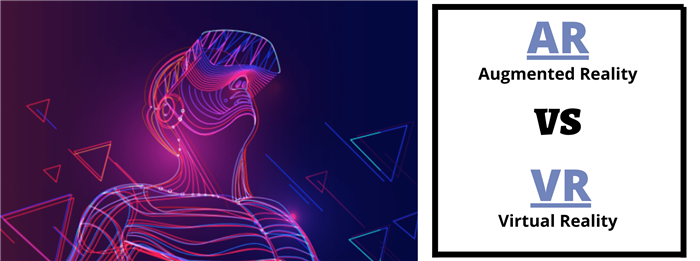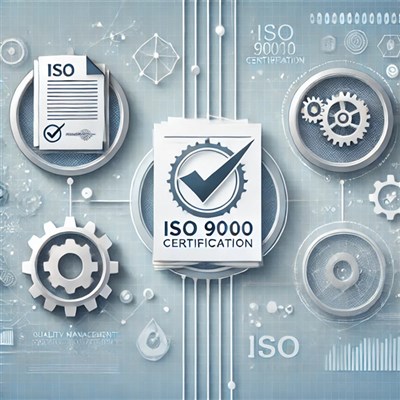
AR and VR technologies have seen rapid growth in adoption and applications over the past decade. Many people use these terms interchangeably to describe any form of altered or simulated reality. However, AR and VR are different from each other in many ways.
Enterprises around the world have adopted AR and VR in some capacity for marketing, training, exercising, education, remote assistance, gaming, entertainment, medication and other diverse domains. If you are looking for a new technology to give your career a direction, it’s better to know the fundamental difference between AR and VR, their real-world applications and how much you can earn from them. It’s clear by now looking at market research, trends and developments that AR and VR technology are not going anywhere any time soon.
AR vs. VR - Overview:
Augmented reality or AR creates a simulated environment by blending digital elements within a real-world environment. AR apps help bring predefined elements into the world to show a different reality.
Virtual reality or VR is a simulation of the world or an alternate reality. Its most common and recognised application is through video games and 3D movies. VR helps in creating a lifelike and immersive experience so that the user becomes a part of this new simulation instead of merely being a spectator. It uses sensory devices and touchpoints to simulate the senses such as VR headsets and haptic gloves.
How Does AR Work?
Augmented Reality technology enhances a user’s physical environment using relevant and real-time simulated content. AR uses digital mapping, computer vision and depth tracking to bring simulating content to an end-user. It uses the camera on a digital device for collecting, sharing and analysing data to share digital content that aligns with what a user is looking at.
How Does VR Work?
Virtual Reality technology focuses on simulating a user’s vision. It requires an additional gadget such as a headset or glasses that users place over their eyes. This is meant to eliminate any real-world interactions and make the VR experience more immersive. Over the years, there have been several advancements in VR technology which now employs auditory, visual and touch simulation as well. This makes for a highly immersive and realistic experience.
Also Read: What Is vSphere? An Introduction to VMware’s Virtualization Platform
Advantages of AR (Augmented Reality):
There are several benefits of AR.
- It offers individual AR learning.
- It fosters a process of learning.
- It has applications in several fields.
- It offers continuous improvement and innovation.
- It increases accuracy.
- It helps educate users and increase awareness and knowledge.
- It helps build shared user experiences across long physical distances.
Advantages of VR (Virtual Reality):
Some of the benefits of VR technology.
- It provides interactive VR learning.
- It increases productivity and capabilities.
- It provides more convenience.
- It helps in creating a realistic world that the user can explore. This world is highly detailed and provides unique experiences that users can choose from.
- Since a VR world is simulated, users can experiment with new experiences and try new things since no real damage can happen.
Limitations of AR (Augmented Reality):
Every technology has its limitations and drawbacks. However, most AR and VR companies are working on eliminating these drawbacks. Hence most of these limitations could be gone by 2025.
Here are some drawbacks of AR technology:
- Development, implementation and maintenance of AR technology are expensive.
- Privacy is lacking in AR implementations today.
- The low level of performance in AR is a huge disadvantage.
- AR is known to cause mental health problems.
- Prolonged exposure to AR can lead to eye problems, obesity and other healthcare problems.
Limitations of VR (Virtual Reality):
Some limitations of VR are as follows.
- VR is being adopted more widely, but no user can realistically interact with this virtual environment.
- People often choose to ignore real-world problems by using VR worlds as an escape. This will become a larger problem with the increasing applications of VR and rising real-world issues.
- Results from training in a VR environment differ significantly from results in a real-world situation. If enterprises wish to replace real-world training with simulations, they will have to create a metric that measures the parity between real-world and virtually simulated results.
AR Applications of Today:
- AR apps are developed and embedded with images, text, videos and other media to create a realistic experience.
- Advertising and printing industries use AR-powered applications to simulate digitally animated content on static physical pages.
- Scanning and translation AR applications help in interpreting various languages and signs instantly.
- In the gaming industry, AR is helping to develop real-world 3D games with minimal additional hardware.
VR Applications of Today:
- The gaming industry is a hotbed for potential and diverse VR applications. Today, VR builds and enhances virtual gaming experiences.
- The military uses VR technology for battlefield simulations, flight simulations and training.
- Many sports and training academies also use VR as a training tool to measure the performance of players and analyse their strategies.
- VR also helps treat post-traumatic stress.
- VR devices like HTC Vive, Google Cardboard and Oculus Rift transport users to imagined and real-world environments such as a rollercoaster or on a battlefield. It can also simulate worlds like mystical castles, distant planets and space travel.
- In the healthcare and entertainment industry, VR provides patients with a safe environment where they can interact with things they are afraid of.
- Medical students practice operations and medical procedures in simulated environments. Using virtual patients helps medical students to practice and develop their skills for real-world applications.
Additional Read: data-science-vs-machine-learning-and-artificial-intelligence
Difference Between AR and VR:
As mentioned before, there are stark differences between AR and VR. Here are the differences you should be aware of before choosing one as a career path.
1. Modifying real-world environments vs replacing reality:
One of the fundamental differences between AR and VR is that AR simply adds digital or virtual elements to an existing physical environment for an augmented visual experience. Meanwhile, VR shuts out the real world and most of its sensations and replaces it with a fully immersive virtual reality. In VR, partial immersion is also an option where the real world is not entirely blocked out. Simulating all human senses in a single experience is not yet possible.
2. Projected revenue growth trajectories differ:
According to market research, the revenue share of VR technology is projected to reach $150 billion in 2022. In comparison, AR saw a growth projection of $30 billion in the same period. While both growth trajectories are substantial considering their limited current applications, VR is looking at significantly larger growth.
3. Different types of working mechanisms:
In AR, the platform can detect predetermined markers like user locations or barcodes to trigger AR activations. The software then delivers the AR animations to the detected locations or markers on the screen.
In VR, the VRML or Virtual Reality Modelling Language experiences generate an engaging sequence of multiple media that a web browser, app or device can fetch to simulate a virtual environment.
4. AR requires greater bandwidth than VR:
According to market research, VR demands 400 Mbps or more for streaming 360-degree VR videos. This is about 100 times more than the current demand by HD video services. 4K videos require at least 500 Mbps and more for VR headsets.
An AR application requires a minimum of 100Mbps at less than a 1 ms delay. It needs at least 25 Mbps for a low-resolution 360-degree video. However, high-quality videos currently cannot deliver close to the camera-level resolution and dynamic range of 360-degree AR videos.
5. Smartphone utilisation vs PC application:
Consumers can easily use AR in 2D and 3D environments like mobile devices. In this situation, the device overlays a digital element in a real-world space. In Virtual Reality, only 3D experiences with a headset provide the high-quality immersive experience that defines VR technology. VR is better suited to PC and computer systems and not as mobile-first as AR. This gives AR an advantage as more and more consumers shift to mobile browsing.
6. Different app development platforms:
Finding applications that use AR and VR technology on phones, computers and other types of devices is quite common. But developing an AR app is quite different from a VR app. Developing 3D experiences and content follows a similar process for both, but developing 2D experiences are different.
Virtual and Augmented Reality Careers and Jobs:
The evolving AR and VR technologies today are creating several new business and employment opportunities. Experts predict that the AR and VR markets will reach a valuation of $209.2 billion by the end of 2022. Hardware and software development, research, graphic design and healthcare are just some of the industries being transformed by these technologies.
You May Also Like: A Complete Guide To VMware Certified Professional (VCP)
Some of today’s most in-demand AR and VR-based job roles and careers are:
- Project management
- Software development
- Software engineering
- Graphic design
- Software maintenance
- Healthcare
- Gaming
If you are looking to develop future-proof skills and build a career with a broad trajectory for growth, both AR and VR technologies are strong career paths. Enrolling in an augmented reality or virtual reality training course will equip you with the skills and knowledge necessary for a successful career. Give your career the boost it deserves and enrol in a training course today.







COMMENT